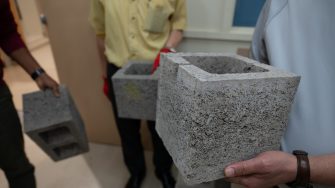Repurposing treated timber for sustainable construction material
A new type of cement block developed at UNSW Canberra presents an exciting prospect for the future of eco-friendly construction.
A new type of cement block developed at UNSW Canberra presents an exciting prospect for the future of eco-friendly construction.

Researchers at UNSW Canberra have developed a green alternative to traditional concrete blocks, addressing both environmental concerns and the rising demand for sustainable construction materials.
Led by Dr Amar Khennane, Dr Jong-Leng Liow and their research team, this innovative approach involves repurposing treated timber waste and mixing it with a geopolymer cement to create a new type of concrete block.
Dr Khennane emphasised the eco-friendly nature of this construction material, highlighting its lightweight composition and potential insulating properties compared to conventional concrete blocks. The geopolymer cement bonded wood blocks also meet the Australian standard for load bearing, making them a viable option for constructing houses up to two stories high.
“The blocks could also be used as an alternative for wall material in construction and reduce the cost of transporting these materials, as the geopolymer cement wood blocks are lighter than traditional concrete blocks, which potentially has a flow on effect to bring the cost of building materials down for a more affordable and sustainable option,” Dr Khennane said.
Australia faces a significant challenge with the accumulation of timber waste in landfills. Treated timber is particularly difficult and expensive to dispose of due to its toxic chemical additives.
Dr Khennane highlighted the environmental benefits of utilising this waste, as approximately 6 percent of Australia's total waste is comprised of timber.
“Repurposing this substantial volume of wood waste into an alternative building material not only addresses environmental concerns of the wood stockpiling, but could also offer a more affordable and sustainable option for construction projects,” Dr Khennane said.
The research also focused on repurposing chromium copper arsenic treated wood, which they first stripped the chemical from and turned into wood chips. These wood chips were left to dry out before being mixed with a geopolymer cement mix that was then shaped into the typical concrete block.
They found the decontaminated wood chips significantly improved compressive, flexural, and specific strength, as well as fracture toughness when compared to their non-decontaminated counterparts. The results of this are promising and represent a significant leap towards eco-friendly construction practices.
Addressing concerns about fire risk, Dr Khennane said research showed that the material doesn't combust. Instead, it forms a char when exposed to fire, serving as a natural fire retardant that prevents the spread of flames.
Looking ahead, the research team would like to construct a small cabin using this innovative material, contingent on securing funding. This next phase will allow for comprehensive research and testing, exploring how the material may impact a house's energy rating and potentially reduce energy bills.
UNSW Canberra's initiative represents a significant stride toward sustainable construction practices, offering a glimpse into a greener and more efficient future for the building industry.